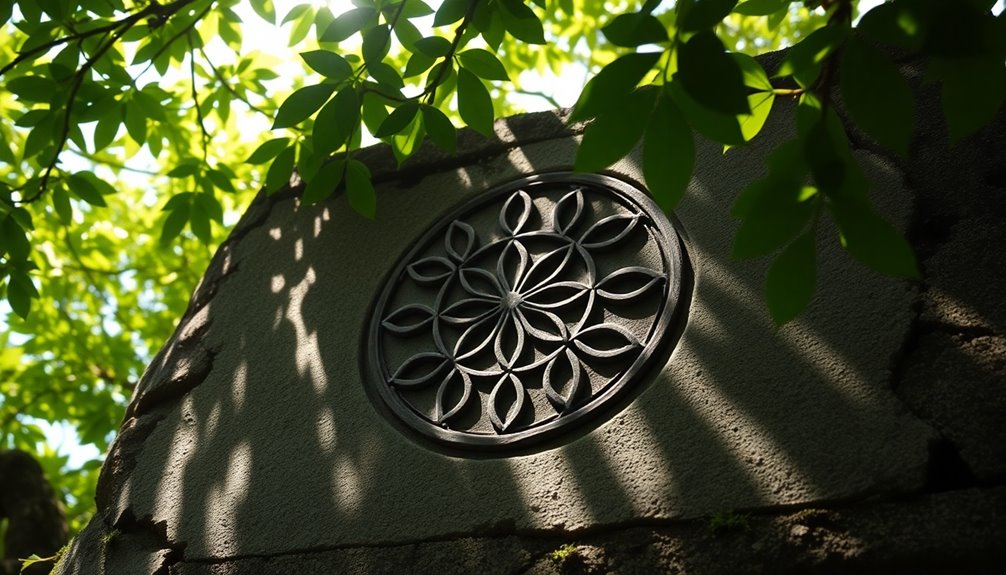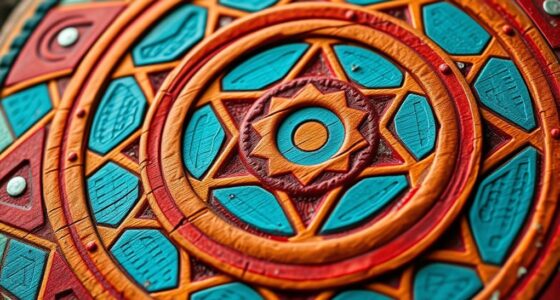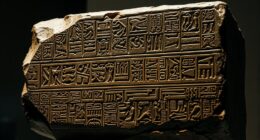The Flower of Life is a sacred symbol made of 19 overlapping circles that some believe may predate all known civilizations. This ancient motif, found in places like the Temple of Osiris in Egypt, is deeply intertwined with spirituality and geometry. Throughout history, it's represented unity and the fundamental building blocks of creation, showing up in various cultures worldwide. Many people view it as a universal blueprint for existence, emphasizing interconnectedness among all life. If you're curious about its broader implications and significance, there's much more to uncover about this fascinating symbol.
Key Takeaways
- The Flower of Life's oldest depiction dates back over 6,000 years in the Temple of Osiris, Egypt, suggesting ancient origins.
- Its presence in Sumerian art and ancient Chinese temples indicates widespread recognition across various ancient cultures.
- The symbol's mathematical significance and connection to cosmic order imply that it may have emerged before recorded civilization.
- Cultural reverence by ancient Egyptians and acknowledgment by figures like Leonardo da Vinci highlight its long-standing importance throughout history.
- The Flower of Life's universal themes of interconnectedness resonate across cultures, suggesting it may embody ancient wisdom predating formal civilization.
Definition of the Flower of Life
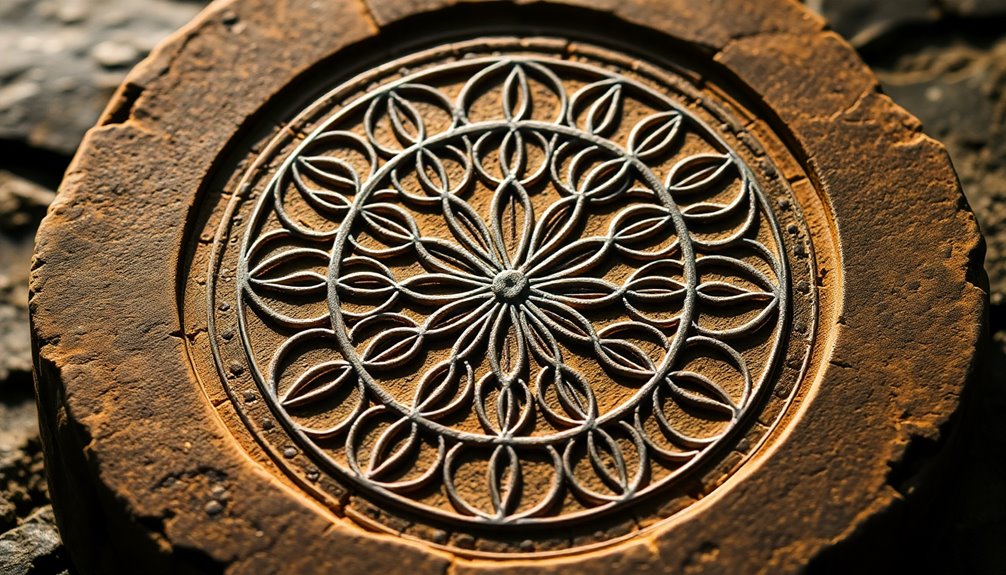
The Flower of Life is an intriguing geometric pattern that consists of 19 overlapping circles of equal size, symbolizing the interconnectedness and harmony found in existence.
This ancient symbol begins with the vesica piscis, created by two circles intersecting, and expands to include the Seed of Life, which comprises seven interconnected circles. Together, these designs represent the origins of creation and the fundamental building blocks of life.
As you explore the Flower of Life, you'll discover its deep ties to Sacred Geometry, revealing the spiritual meanings hidden within its structure.
This intricate pattern serves as a visual representation of the cosmic order, illustrating how everything in the universe is connected.
The Flower of Life has surfaced in various ancient cultures, with its oldest known depiction located in the Temple of Osiris in Abydos, Egypt, dating back over 6,000 years.
Historical Significance and Origins
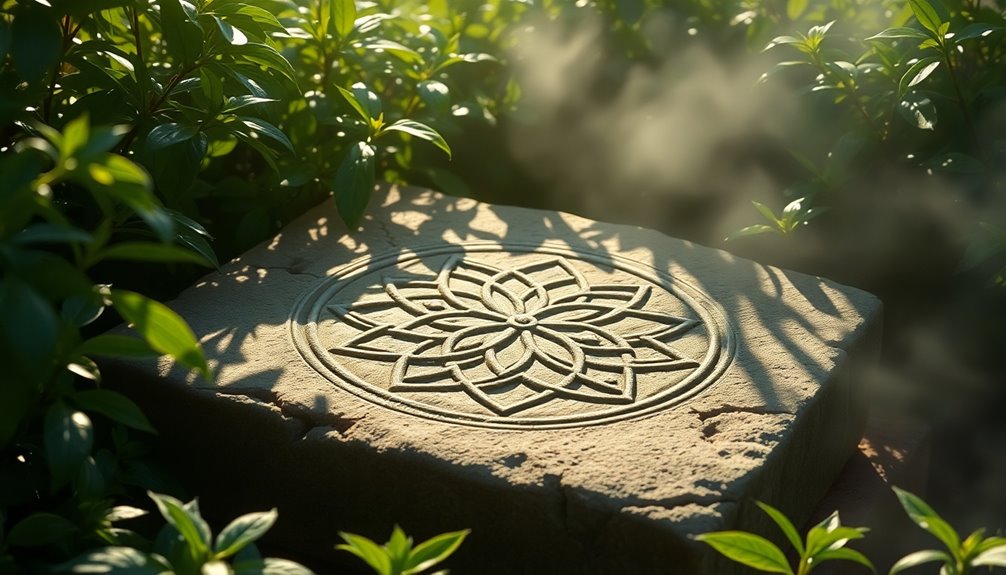
How did the Flower of Life become such a revered symbol across different cultures? This intricate design has been found in artifacts that date back over 6,000 years, with the earliest representation located in Egypt's Temple of Osiris.
Its historical significance spans ancient cultures, appearing in Sumerian art, ancient Chinese temples, and synagogues in Israel. Each instance showcases a shared understanding of sacred geometry, highlighting humanity's quest for meaning and connection.
The Flower of Life encapsulates essential concepts of creation and interconnectedness, often seen as a divine blueprint illustrating the structure of existence.
Even Leonardo da Vinci recognized its mathematical and artistic importance, incorporating its patterns into his work to express harmony between the physical and metaphysical domains.
The widespread presence of this symbol in ancient architecture and artwork serves as evidence of intelligent design, suggesting that these civilizations grasped profound truths about the cosmos.
Through its timeless appeal, the Flower of Life continues to resonate with various spiritual traditions, reminding us of our interconnectedness and the universal patterns that bind us all.
Symbolism in Sacred Geometry
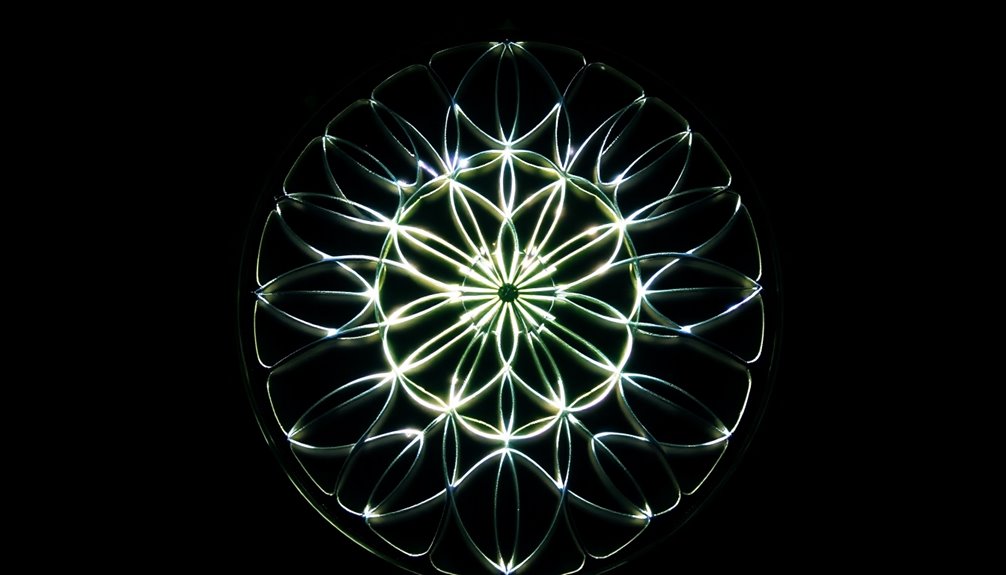
Interconnectedness lies at the heart of the Flower of Life, making it an essential component of Sacred Geometry. This intricate geometric pattern, consisting of 19 overlapping circles, symbolizes the divine creation and the unity of all life. It showcases principles of balance and harmony, offering a blueprint for existence that transcends cultural boundaries.
Consider the following elements that enhance its spiritual meaning:
- Vesica Piscis: This foundational shape illustrates the birth of duality and the merging of opposites.
- Seed of Life: It represents the seven stages of creation, depicting the growth of life from a singular point.
- Flower of Life: As the culmination of these shapes, it embodies the interconnectedness of all beings and the universe's divine order.
Sacred Geometry, including the Flower of Life, serves as a profound tool for understanding the deeper mysteries of existence. Its presence across ancient civilizations, like Egypt and Sumer, highlights its historical significance and the universal truths it conveys.
Cultural Presence Across Civilizations

Throughout history, the Flower of Life has captivated civilizations, appearing in diverse cultures as a powerful symbol of unity and creation. This intricate design of 19 overlapping circles has been found across various ancient cultures, showcasing its significance in representing interconnectedness and sacred geometry.
Here's a quick overview of where the Flower of Life has appeared:
| Culture | Location | Significance |
|---|---|---|
| Ancient Egypt | Temples in Egypt | Oldest known representation, 6,000 years old |
| Jewish Tradition | Synagogues in Israel | Symbol of spiritual concepts |
| Ancient Rome | Mosaics in Pompeii | Reflected in European art and architecture |
| Buddhism | Various sites in Asia | Represents universal themes |
| China | Historical sites | Emphasizes interconnectedness |
The global presence of the Flower of Life in ancient art and architecture reveals a shared understanding of universal themes across civilizations. Each culture embraced the symbol, weaving it into their spiritual concepts and artistic expressions, highlighting its enduring relevance throughout time. This interconnectedness is akin to the way educational toys foster cognitive growth and social skills in early childhood development.
Spiritual Connections and Interpretations
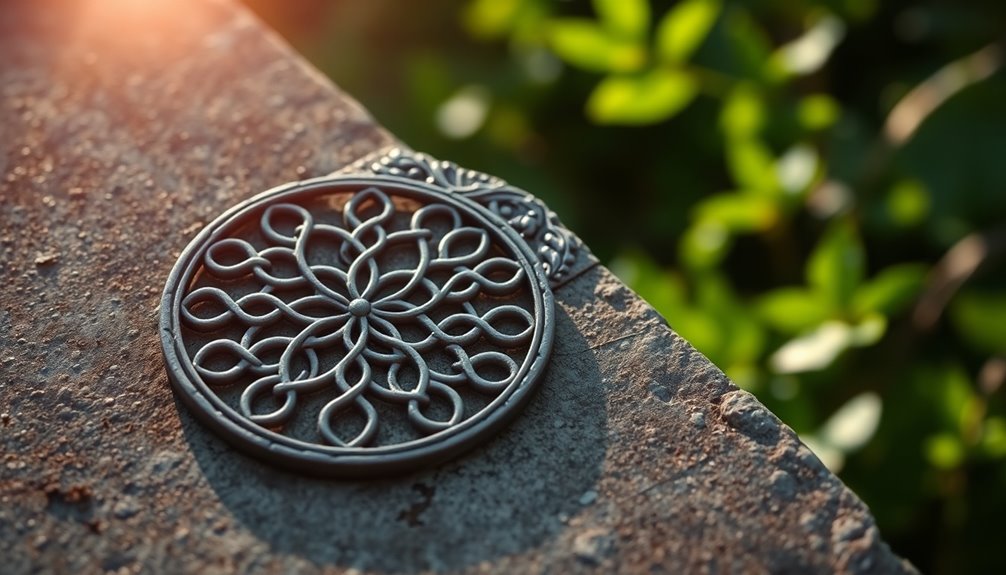
The Flower of Life symbol serves as a universal spiritual blueprint, connecting you to the essence of existence.
It highlights the interconnectedness of all beings, reminding you that your journey is part of a larger cosmic tapestry.
Universal Spiritual Blueprint
Many spiritual practitioners see the Flower of Life as a profound symbol of a universal spiritual blueprint, illustrating how all life and creation are intricately linked.
This ancient design, rooted in sacred geometry, transcends civilizations and resonates with diverse spiritual teachings. It's a reminder of the interconnectedness that binds us all, inviting you to explore deeper meanings in your existence.
Consider these three aspects of the Flower of Life:
- Patterns of Creation: The symbol embodies the intricate patterns from which all life emerges, emphasizing a divine order in the cosmos.
- Spiritual Enlightenment: Many believe it serves as a gateway to enlightenment, offering insights into your spiritual journey and relationship with the universe.
- Unity of Beings: The Flower of Life encourages you to recognize your integral role among all beings, fostering a sense of unity and collective consciousness.
Through its rich history and spiritual significance, the Flower of Life acts as a lens, helping you appreciate the profound connections that exist within creation and the sacred dimensions of existence.
Interconnectedness in Existence
While exploring the depths of existence, you may find that the Flower of Life serves as a profound reminder of the interconnectedness that binds all beings. This intricate design of 19 overlapping circles represents a divine blueprint for creation, illustrating how everything in the universe is interdependent.
Ancient civilizations, such as the Egyptians and Sumerians, embraced this sacred geometry to express their understanding of life's holistic nature.
The Flower of Life encapsulates deep spiritual wisdom, highlighting your essence within a unified field. It reflects the idea that all elements of existence play crucial roles in a greater whole, similar to ecosystems where each component contributes to overall harmony.
As you investigate its meanings, you might discover how this symbol resonates with themes of creation, order, and interconnectedness found in various religious texts.
In modern interpretations, the Flower of Life continues to inspire awareness of this interconnectedness, encouraging you to recognize your place within the vast web of life.
Mathematical and Geometric Insights
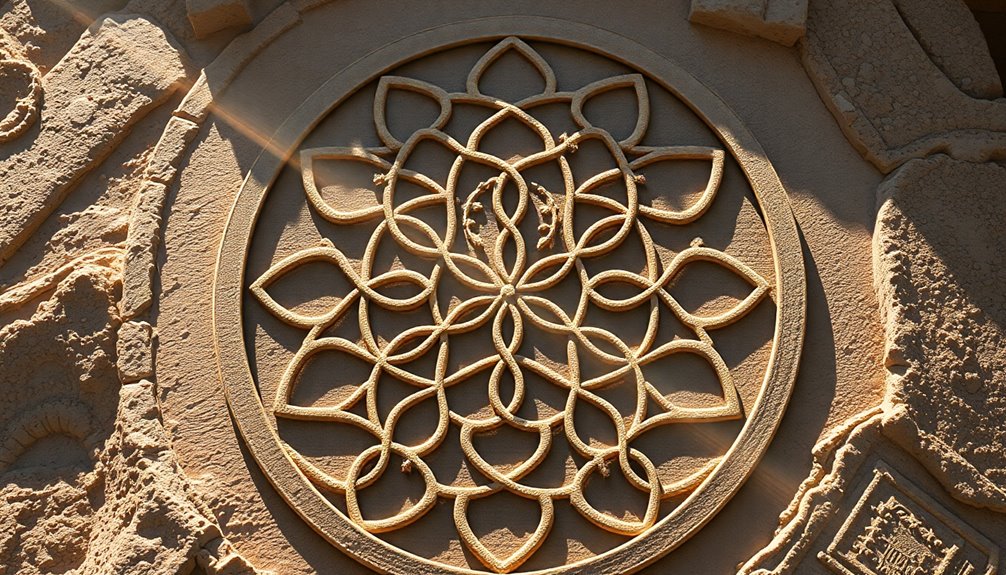
When you look at the Flower of Life, you can see its intricate geometric structure formed by 19 overlapping circles.
This design isn't just visually appealing; it holds significant mathematical relationships that reflect nature's ratios and proportions.
Geometric Structure Explained
Exploring the geometric structure of the Flower of Life reveals a fascinating interplay of circles that embodies balance and harmony. This intricate design consists of 19 overlapping circles of equal size, showcasing perfect radial symmetry, a hallmark of sacred geometry.
At its core, the structure begins with the vesica piscis, formed by the intersection of two circles, which serves as a foundational element.
The Flower of Life also includes the Seed of Life, comprised of seven interlocking circles that symbolize the initial stages of creation. This interconnectedness illustrates the complexity inherent in the Flower of Life.
You can visualize this connection through:
- Interlocking Circles: Each circle overlaps, creating a web of relationships that echo natural patterns.
- Five Platonic Solids: The Flower of Life encompasses these fundamental shapes, linking geometry to existence itself.
- Mathematical Patterns: The design reveals deeper insights into the universe's structure, connecting scientific and philosophical ideas.
Ancient Egyptian civilizations revered this symbol for its profound meanings, emphasizing the interconnectedness of all life and the underlying mathematical patterns that govern our world.
Mathematical Significance Highlighted
The mathematical significance of the Flower of Life extends beyond its beautiful design, revealing profound insights into the universe's structure. This intricate symbol consists of 19 overlapping circles, showcasing complex mathematical relationships and symmetry that reflect divine order. Each element correlates with significant geometric forms, including the Five Platonic Solids, emphasizing the interconnectedness of existence.
Leonardo da Vinci recognized the Flower of Life's profound implications and integrated its patterns into his artwork, illustrating harmony between physical and metaphysical domains. The design's foundation, the vesica piscis, symbolizes creation through the intersection of two circles, embodying core principles of sacred geometry.
| Aspect | Description | Significance |
|---|---|---|
| Flower of Life | 19 overlapping circles | Represents universal order |
| Vesica Piscis | Intersection of two circles | Symbolizes creation |
| Platonic Solids | Fundamental geometric forms | Reflects interconnectedness |
The Egg of Life, derived from this pattern, connects to musical intervals and cellular division, underlining the mathematical foundations of life itself. This ancient symbol invites you to explore the deeper meanings hidden within its intricate design.
Practical Applications in Daily Life
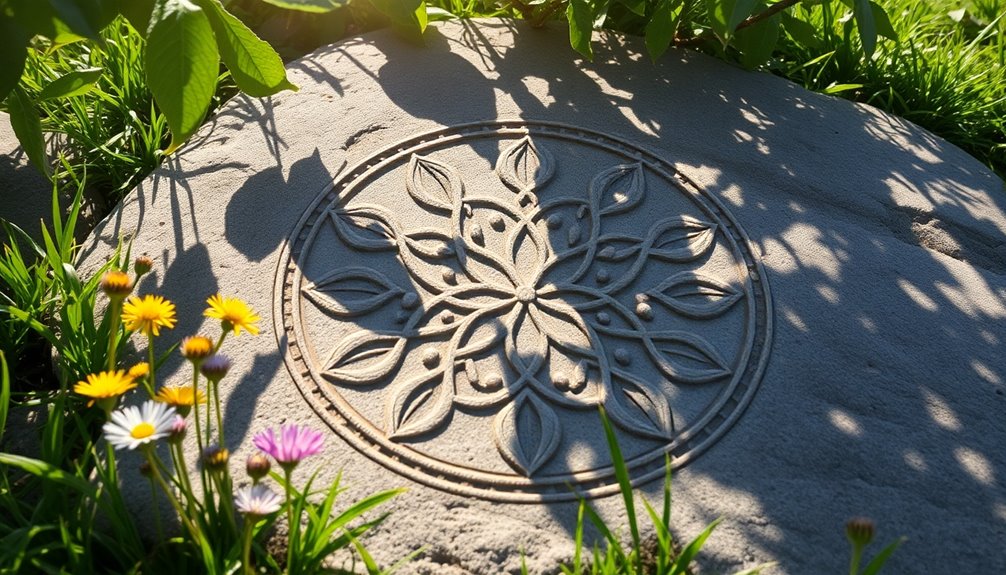
Incorporating the Flower of Life into your daily routine can transform mundane moments into opportunities for spiritual growth and mindfulness. This symbol, rooted in sacred geometry, serves as a powerful tool for enhancing your meditation practices and personal reflections.
Here are three practical ways you can embrace the Flower of Life:
- Home Decor: Adorn your space with wall art or textiles featuring the Flower of Life. This creates a sacred space, promoting tranquility and harmony while connecting you to universal energy.
- Jewelry: Wear necklaces or bracelets showcasing the Flower of Life. These pieces act as personal talismans, constantly reminding you of your interconnectedness with all life and your journey toward personal growth.
- Crystal Grid Work: Use the Flower of Life pattern in your crystal grid work. This enhances the healing properties of your crystals, creating a potent energetic field that supports protection, manifestation, and spiritual alignment.
The Flower of Life in Modern Contexts
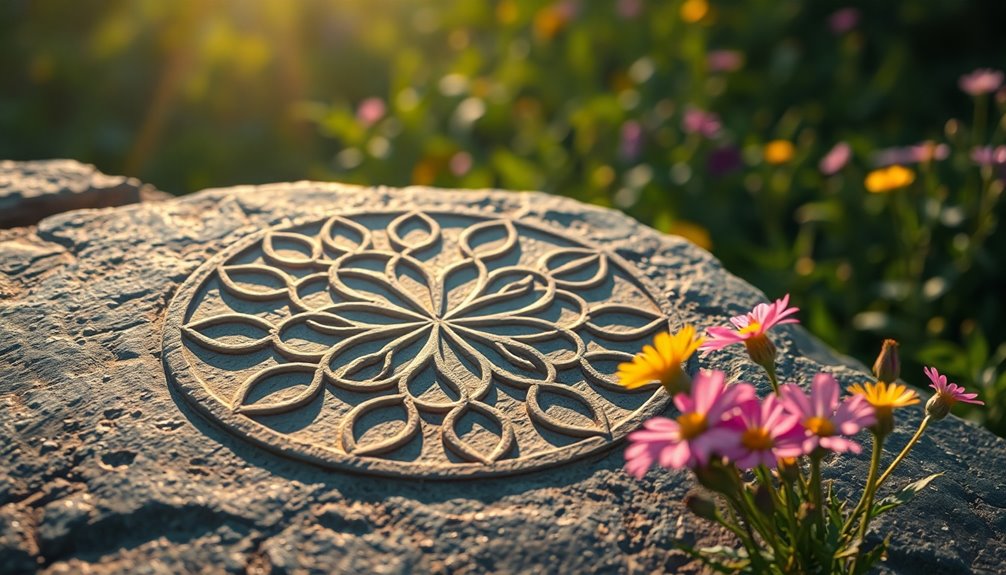
Throughout history, the Flower of Life has evolved into a dynamic symbol that resonates with modern sensibilities. Today, you'll find it integrated into various aspects of life, from body art to spiritual practices, reflecting its deep significance and aesthetic appeal.
| Modern Expression | Significance |
|---|---|
| Body Art (Tattoos) | Personal expression and identity |
| Jewelry | Symbol of protection and beauty |
| Meditation Kits | Enhances relaxation and personal growth |
In contemporary spiritual practices, the Flower of Life is often included in meditation kits, creating an ideal atmosphere for introspection and personal growth. Its representation of interconnectedness speaks to modern philosophies, bridging ancient wisdom with current understandings of existence.
You might also see the symbol in amulets or talismans, where it serves to promote positivity and spiritual awareness. With varied color choices, from vibrant hues to classic black, the Flower of Life allows for longevity and personal expression in art. As you explore these modern contexts, you'll discover how this ancient symbol continues to resonate deeply in today's world.
Frequently Asked Questions
Is the Flower of Life the Oldest Symbol?
You might wonder if the Flower of Life is the oldest symbol.
While it's certainly one of the most ancient, with roots tracing back over 6,000 years, definitive proof of it being the absolute oldest remains elusive.
Various cultures have used similar geometric patterns throughout history, suggesting it's part of a broader human heritage.
Its significance may have evolved, but claiming it as the oldest symbol isn't straightforward without more concrete evidence.
Where Does the Flower of Life Originate?
Imagine walking through ancient temples, where the Flower of Life first emerged.
This symbol likely originates from the Temple of Osiris in Abydos, Egypt, around 6,000 years ago. Its intricate design, featuring 19 overlapping circles, showcases a profound understanding of Sacred Geometry.
You'll find it echoing through various cultures, from Chinese temples to synagogues in Israel, revealing its widespread historical significance and influence across civilizations and eras.
What Does the Flower of Life Mean in Ancient Egypt?
In ancient Egypt, the Flower of Life symbolized the interconnectedness of all life forms.
You'd find it representing divine creation and the universe's blueprint. The intricate design, made up of 19 overlapping circles, showcases the Egyptians' advanced understanding of mathematics and cosmology.
It embodied the essence of life, linking fertility and creation to the cyclical nature of existence, making it an essential part of their spiritual and religious practices.
What Is the Flower of Life in Mesopotamia?
Imagine a tapestry woven with the threads of the universe's secrets. That's the Flower of Life in Mesopotamia!
This ancient symbol, found in Sumerian art, embodies the interconnectedness of all existence. You'll see it representing creation, divine order, and the cyclical dance of life.
Sumerians revered it for its ties to fertility and nature, reflecting their deep respect for the cosmos and the life-giving forces that shape their world.
Conclusion
In exploring the Flower of Life, you uncover a tapestry woven through time, connecting ancient wisdom and modern insight. This symbol, rich in history and meaning, invites you to see the world in a new light, revealing the intricate patterns that bind us all. As you embrace its teachings, you might find a deeper understanding of your place in the universe, reminding you that you're part of something much larger than yourself—a beautiful dance of existence.

